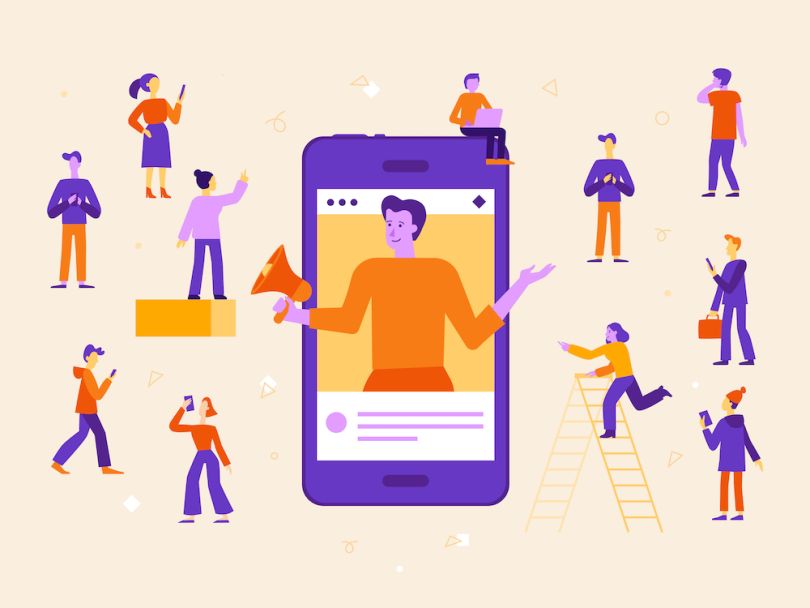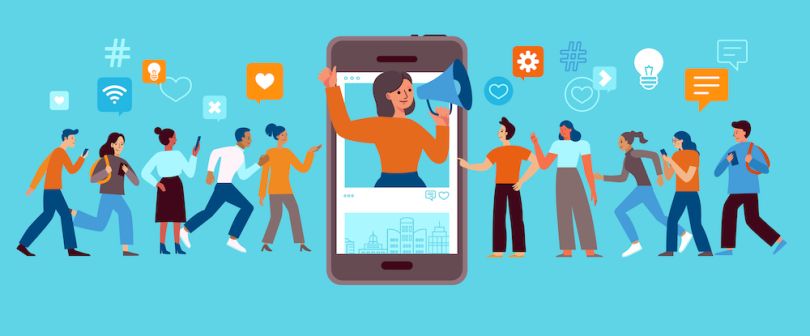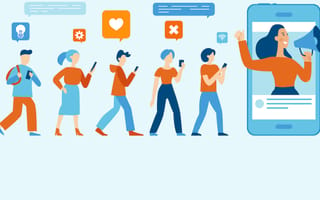Remember Coachella 2018? Beyonce headlined that year, putting on a show that referenced big bands, pep rallies and decades of Black history. She sampled Nina Simone. Jay-Z made a cameo. One critic called it “a baptism.”
Another spectacle at the festival made smaller, more targeted waves, though: the brand activations, like Hewlett-Packard’s Lab and Lounge.
From the outside, it looked like a geodesic dome. Inside, an ethereal sci-fi world unfolded — what HP called a “digital Eden.” Artists used HP technology to create light paintings, and visitors could use HP laptops to design and print custom water bottle decals.
Influencers abounded. Hang Nguyen, Mallory Joy and Jasmine Rose visited the dome at Coachella and Panorama, the other stop on its music festival tour.
That’s in part because it was surreal — it had a certain “cool factor” — and in part because it was designed with the logistics of influencing in mind, explained Collectively CEO Ryan Stern; her influencer marketing agency worked on the dome with HP.
When it comes to experiential activations, “[t]he space is a set,” Stern said, “complete with the right lighting, backgrounds, and details big and small to convey whatever messages or brand values need to be communicated.”
That requires consideration of key questions: Can influencers photograph without flash? Is it too loud for influencers to record commentary? How and where are brand logos visible?
It’s true that influencers didn’t make Coachella headlines the way Beyonce did — they primarily chronicle their own lives — but they’re a marketing force to be reckoned with. Business Insider estimates brands spent $8 billion on influencer marketing in 2019, and forecast that number will nearly double by 2022.
Also, they got HP, a $26 billion corporation that primarily makes computers and printers, to build them a desert playhouse for free.
What is influencer marketing?
That’s especially striking because influencers and tech weren’t always natural partners. When influencer marketing first took off in the mid-2010s, the brands that led the charge were lifestyle companies, like FabFitFun. Influencers congregate on visual platforms, and it’s easier to strike an alluring pose with a tube of make-up than with a desktop computer.
At this point, though, influencer marketing has reached every sector, including consumer tech, B2B tech and tech accessories. In fact, Stern argued that an influencer with the right audience and narrative could sell a lowly power cord.
So how does this work, exactly? Stern walked us through the basics.

Influencer Marketing 101: FAQs Answered
What is influencer marketing?
Influencers have audiences of social followers who engage with them, trust them and look to them for advice, typically within a certain niche. An influencer might be most trusted on fashion, or parenting, or veganism — or tech.
Influencer marketing means an influencer shares some kind of paid content with their audience. On Instagram, where influencer marketing first took off, these posts include the disclaimer hashtag “#ad,” and usually come with a caption that blends a product description with a recommendation.
Stern noted that different marketing objectives are attained through different post styles and frequencies. A product launch, for instance, might look different than an influencer executing a two-year brand ambassador contract.
Who counts as an influencer?
Anyone sharing promotional content with an audience of “more than just their friends and family” can, at least in theory, function as an influencer.
“At the end of the day, it can be someone that has 50 followers but is really influential in their decisions and how they purchase or think about brands and products,” Stern said.
In fact, she said, influencers with smaller, more engaged audiences can often make a bigger splash than influencers with massive audiences.
How do companies find influencers?
There are a variety of search tools that help companies find influencers, including SparkToro and TikTok’s creator marketplace, but “there’s so much complexity in what makes a great fit,” Stern said.
Companies need to consider the influencer’s audience size, audience composition, ethics or lack thereof, schedule and collaboration style. Another consideration: whether the influencer is up for the job.
At Collectively, the team lets influencers “raise their hands” to work with brands they think their audience will appreciate.
This can especially help tech companies, she said— if Apple, for instance, works with an influencer that already uses Apple products, the #ad will look authentic in that influencer’s feed, gelling with previous laptop, phone and tablet cameos.
What goes on behind the scenes of influencer marketing?
Short answer: a lot.
Influencers and brands often collaborate behind the scenes on image selection and caption copy, turning skeletal creative briefs into posts with personality. Stern recommends that client companies take the partnership a step further, and integrate influencers into their full product lifecycles. Why not use influencers as beta testers for products, and messaging?
An influencer, after all, is “someone to really bring you valuable feedback as a user, and someone who thinks both like a content creator and a marketer,” Stern said.
How do influencers get paid?
“Payment per post is the norm,” Stern said.
But cash payment is just one aspect of most influencer marketing deals. Brands and influencers exchange “different forms of value,” Stern said. Brands can compensate influencers in free products, exposure and charitable contributions, as well as direct payments.
How do you measure influencer marketing’s performance?
It depends on the objectives of the campaign. “Influencer marketing can be very impactful across all stages of the funnel,” Stern said — and each stage, from awareness through to decision, has its own performance metrics. For awareness, the metric might be impressions; for lower-funnel campaigns, it might be sales revenue.
At Collectively, Stern and her team add another dimension to core quantitative metrics with qualitative “conversational analysis.” In other words, they evaluate the comments on influencers’ posts. A comment like, “This is really cool, I’ve never heard of this before!” would indicate a successful product launch post; something like “I didn’t know this company was so committed to sustainability” would signal that a well-known brand was successfully shifting public perception.

Influencer Marketing 201: Can It Work for Tech Companies?
Today, tech companies may not be able to orchestrate Coachella activations — Coachella 2020 has been canceled due to the coronavirus — but that doesn’t mean the tech industry will pause its influencer marketing.
“Especially in the tech space, customers do a lot of research,” Stern said. “They’re Googling, they’re looking for reviews — they’re looking to be influenced.”
She had some tech-specific strategy pointers too.
Top Influencer Marketing Strategies for Tech Companies
- Experiment with longer-form content, like vlogs and blog posts
- Reimagine the product demo with reviewers and lifestyle influencers
- If you’re in the B2B tech sector, give influencers access to in-house experts
First: Instagram isn’t everything. Yes, HP’s photogenic Coachella activation drove awareness and engagement — by Collectively’s estimate, content from the Lab and Lounge made as many as 20 million impressions. However, longer-form content like a YouTube video or a blog post can more effectively demonstrate the ins and outs of a complex product.
In popular YouTuber Marques Brownlee’s review videos, for instance, he walks through every feature of hardware like the Samsung Galaxy Note 20 Ultra, demoing everything from the camera to the stylus’ optional scribbling sound effect.
Reviewers like Brownlee — who has just shy of 12 million YouTube subscribers — have a particularly fine line to walk when it comes to influencing, though, because they need to maintain their credibility.
“The [audience] will be quick to point out ... if it’s feeling too much like [he’s] selling out for one brand,” Stern said.
Reviews help spread the word, but reviewers can’t promise positivity. Lifestyle influencers can, though. In this era of working from home, for instance, they can show how a specific piece of technology contributes to their home office set-up.
Stern recommends this as an authentic, “person to person” reimagining of tech’s choreographed, Steve Jobs-esque product demos.
For B2B tech companies, influencers can also create journalistic, educational content, drawing on the opinions of in-house experts, like Brownlee’s interviews with tech luminaries. The experts don’t have to be Bill Gates to say something of value, Stern noted. A product manager or an engineer can still take an influencer behind the scenes, giving their audience a glimpse of a company’s innovation and personality.
“Audiences are smart. They want great content that feels genuine.”
Ultimately, though, the tech sector needs to follow the same best practices as every other company when it comes to influencer strategy. That means they can’t lose sight of quality, or the fit between influencers’ brands and their own.
“Audiences are smart,” Stern said. “They want great content that feels genuine.”
Sometimes, that’s a glamour shot with a laptop. It’s hard to pull off, as we mentioned earlier, but not impossible — just look at this HP collaboration with beauty YouTuber Bretman Rock. Wearing snakeskin-print pants, he lounges in the sun with an HP Spectre x360 and a cocktail.
One Twitter user said of the photo, “This is literally making me want to buy a computer.”




